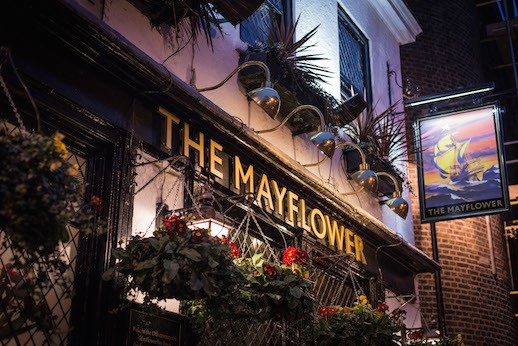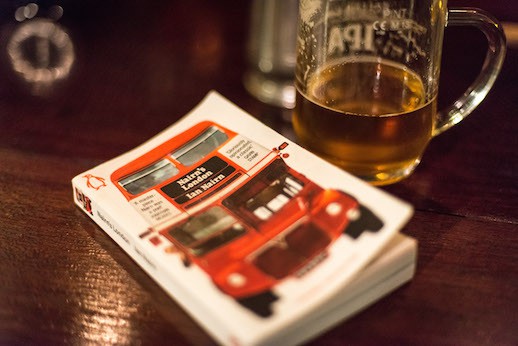In 1966, Ian Nairn penned a masterpiece: a one-man meander through our capital that taught readers to see beauty where others saw decay. Some 49 years on, Ben McCormick picks up the baton to write his own paean to London pub culture.
I love pubs. Ever since I was four and was left outside the Roseberry Arms (now flats) in Cheddington by my dad, swinging my legs on the rotting trestle table while I nursed a bottle of Coke and a packet of Golden Wonder crisps. A bad-tempered Dad was inside the mysterious mock-Tudor building for what felt like a long time (though was probably only enough time to buy a pint and chat with the locals). When he emerged, he was sporting a glass of brown liquid and a toothy smile.
What wonders had effected such a change in the man? I stuck my head around the door and was overwhelmed by the stench of dank, keg ale-soaked carpet and half a century’s fag smoke, which sent me running for the sanctuary of the concrete beer garden.
I was given my first taste of beer that afternoon. I hated it. I wondered how anyone could drink the stuff. It would take another 10 years for my palate to get used to the idea, but the allure of pubs never faded. I was fascinated with their names; the fact they were almost always preceded by the definite article; the little white wooden signs above the door that say: “Licensed to sell intoxicating liquor.” To this day, I’m still struggling with the contradiction between my childlike wonder at the transformative effect they can have on people and the often grim reality of the places themselves.
When I moved to London, I began to appreciate the better pubs; those with a certain something I couldn’t quite place. I started to take notes; collecting the good and dismissing the dismal. I soon developed a compendium – the drinker’s equivalent of the cab drivers’ Knowledge. I added to it for years.
Since arriving in the capital, I’ve noticed the pub landscape change dramatically. Once famous chains are gone, others have sprung up in their stead and the beer market itself has undergone a radical upheaval. Mostly for the better, but not always. It’s the closures that made me put down my pint glass, stare wistfully into the distance and take notice. We are losing pubs at an alarming rate (up to 39 a week depending on which figures you believe) and, although new ones are opening, the general trend is one of decline.
In October 2014, I had a stinker of a month, but one thing kept me going: a book called Nairn’s London in which the author, architectural correspondent and heavy drinker Ian Nairn documented the buildings that inspired him in our capital city. Among them were 27 pubs, with a further 50-odd mentioned in passing.
Ostensibly a guidebook to 11 different areas of the city, Nairn’s London is, as the author puts it, “A record of what has moved me between Uxbridge and Dagenham.” It’s written with the astute, pointed wit you’d expect of the man who coined the term “subtopia” to damn ill-planned and depressingly homogeneous suburbs and delivered in the tone of an irascible uncle who’s just warming to his theme after several pints.
Nairn’s book is quite possibly a work of genius. His one-man metropolitan meander through the capital provoked tears of sadness and joy, wonder, the dawning light of new revelation and an immediate vow to look at things in a different way. After one chapter, I’d looked up more terms in the architects’ vernacular than I ever thought would be necessary in a lifetime. By section two, I felt my appreciation of the English language burgeoning with every entry and had already committed myself to several church visits (I will do this!). But it was by the third part that I realised I was reading a masterpiece. It’s as if he’s been coaxing you gently but insistently into his scheme at the outset. Once you arrived at the northern circle, you’re hooked. That’s when the fun starts. Where it all begins to flow and make sense.
There’s just so much in here, it’s often a struggle to take it all in. He’s the Patrick Leigh Fermor of London’s buildings, easily mirroring that author’s command of metaphor, attention to detail and ability to guide the reader through unfamiliar worlds while instilling in them his same sense of wonder. It’s that skill, a sometimes irritated outlook and his fondness for a pint that, while I was reading, made me feel as if my Dad – long since dead – were guiding me round a world I never knew existed in a city I thought familiar.
And then there were the pubs. Some he delighted in, such as the Victoria in Bayswater – “The feel of drinking here floats in a delicious lacuna mid way between theatre bar, a club and a Baroque library” – while others – The Black Friar in particular – were dismissed as trying too hard. I began to imagine Nairn could quite easily have bumped into my Dad in the Crown on Cricklewood Broadway – also included in the book – around the time he was writing it. I imagine they’d have got on quite well.
While penning such an inspirational book, Nairn had also held a mirror up to the drinking culture he delighted in. One that embodied the essence of ‘pubbiness’ (his own term) and more often than not required the presence of working class people and good draft beer. Some of his favourites were also my own, others were completely unknown, but I felt the need to seek them out, if only to give myself some sense of purpose.
Throughout the book, there’s an underlying sense of foreboding and impending loss, which was particularly apposite for me at the time. I began to wonder what remained of the pubs Nairn had patronised some 50 years earlier. Were they still there, as pubs, and would they still pass muster? There were some included I know have changed massively and he’d doubtless hate them now. Would the ones I now know and love be as radically altered or even still be there in another 50 years?
And so, an idea duly sown, I resolved to visit and write about as many as I could within a year – as a regular blog for Ernest Journal and (possibly, in the future) a book. The plan is to visit Nairn’s original 27, then pick up his trail in seeking out those with a story and those worth preserving. Before I finish, I imagine trends will change, fads will pass and some pubs will close, but no matter. What I’m hoping to create is a window on beer drinking culture in 2015, as well as a celebration of pubs worth treasuring. What I’d like to show is that there’s still so much to love about pubs and, if you can recognise that, you should go and visit your nearest as soon as possible. We really don’t know what we’ve got till it’s gone.
 The Mayflower, Rotherhithe, London SE16Photo: Diana Jarvis
The Mayflower, Rotherhithe, London SE16Photo: Diana Jarvis
Judging by the hue of the wallpaper, a place untouched at least since the smoking ban came into force and one that trades hard on its riverside situ and rich seafaring heritage. There are more artefacts of a nautical bent than you could shake a boom at, rubbing maritime shoulders with quasi-highbrow stencilled quotes about booze from literary luminaries. It’s an irregular verb of a pub, taking little heed of convention until you venture into the most public of public conveniences – ones that afford the user a tremendous view of the adjacent thoroughfare of the Thames Path and the latter’s roamers more of an insight than they might have hoped for on casual glancing. That the pub belongs in the Greene King fold is hard to escape despite its best efforts at subterfuge. Too close to the fine hanging China teacups is a glass phalanx of branded IPA pint pots that suspends belief. Behind the bar, a decapitated alligator is caught mid-chew of a miniature whisky bottle, its dead-eyed, dessicated glare captured forever in much the same way as the pub’s ‘snapshot-in-time’ atmosphere. There’s enough here to catch the eye but little to genuinely hold the attention or interest. That is, until you explore the pub’s greatest feature. Step outside the door, pace the few yards through the B&Q-tented village and you’ve reached the end of the plank and the start of this place’s natural wonder: The Thames. Because while you listen to overpaid bankers talking about oil prices and so-called trickle-down economics, you can gaze out at the lapping river and imagine yourself for a fleeting moment surveying your watery way out to the high seas of Conrad or down the dingy waterfront alleyways of Dickens. Real horror stories lived visceral lives here. The stark contrast between the brash, garish lights of capitalism and the dark, decaying dankness of the river’s sodden bank comes into focus as you survey the overwhelming scene of emptiness. Full of everything and giving nothing of permanence and value. That a fast ship carves liquid lines to provoke turbulence at the water’s edge seems apposite. The flash creating waves it cannot possibly predict or comprehend. Only the mist of the tier and the haze brought on by the well-kept beer softens the blow. But venture back in from the cold and there is just enough of a welcome in the softened, curved and uneven edges to revive the spirits. This place walks an edgy gangplank between the corporate and the idiosyncratic – it has what you may need without ever really letting you forget what’s enabled you to enjoy its conviviality. Much like the scene you can view dispassionately outside, The Mayflower offers both misery and reconciliation in enough of an equal measure to make you happy to return. Whether or not that fine line can be trodden for long is anyone’s guess. But that’s the same uncertainty that haunts whatever else we might still wish to conserve outside and elsewhere. One of the best things is that, as a lone drinker, you get to see it from many perspectives as you are forced to flit from seat to bar to table, never able to settle or fix bearings or maintain a single spot.
Ernest Journal is a biannual publication created for people who love to build fires, who’d like to learn how fly fish, brew beer in their shed, name all the constellations of the northern hemisphere and run full pelt into the sea.
Ben McCormick is Caught by the Beer’s regular beer enthusiast. His words, straight from the brewery tap, are archived here.
Copies of Nairn’s London can be found for sale in the Caught by the River shop, priced £9.99
